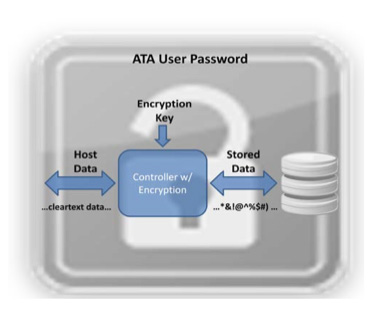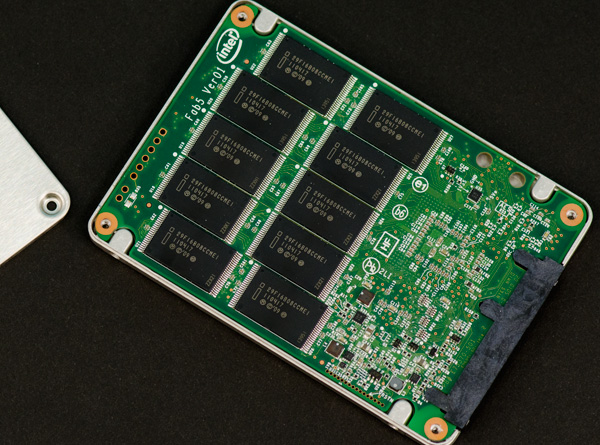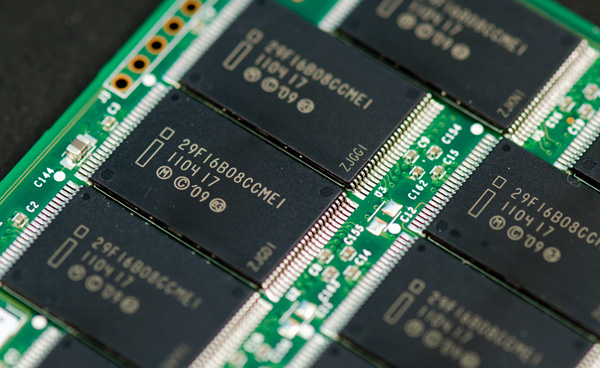The Intel SSD 320 Review: 25nm G3 is Finally Here
by Anand Lal Shimpi on March 28, 2011 11:08 AM EST- Posted in
- IT Computing
- Storage
- SSDs
- Intel
- Intel SSD 320
Spare Area and Redundant NAND
Intel's controller is a 10-channel architecture and thus drive capacities are still a little wonky compared to the competition. Thanks to 25nm NAND we now have some larger capacities to talk about: 300GB and 600GB.
Intel sent a 300GB version of the 320 for us to take a look at. Internally the drive has 20 physical NAND devices. Each NAND device is 16GB in size and features two 64Gbit 25nm 2-bit MLC NAND die. That works out to be 320GB of NAND for a drive whose rated capacity is 300GB. In Windows you'll see ~279GB of free space, which leaves 12.8% of the total NAND capacity as spare area.
Around half of that spare area is used to keep write amplification low and for wear leveling, both typical uses of spare area. The other half is for surplus NAND arrays, a RAID-like redundancy that Intel is introducing with the SSD 320.
As SandForce realized in the development of its controller, smaller geometry NAND is more prone to failure. We've seen this with the hefty reduction in rated program/erase cycles since the introduction of 50nm NAND. As a result, wear leveling algorithms are very important. With higher densities however comes the risk of huge amounts of data loss should there be a failure in a single NAND die. SandForce combats the problem by striping parity data across all of the NAND in the SSD array, allowing the recovery of up to a full NAND die should a failure take place. Intel's surplus NAND arrays work in a similar manner.
Instead of striping parity data across all NAND devices in the drive, Intel creates a RAID-4 style system. Parity bits for each write are generated and stored in the remaining half of the spare area in the SSD 320's NAND array. There's more than a full NAND die (~20GB on the 300GB drive) worth of parity data on the 320 so it can actually deal with a failure of more than a single 64Gbit (8GB) die.
Sequential Write Cap Gone, but no 6Gbps
The one thing that plagued Intel's X25-M was its limited sequential write performance. While we could make an exception for the G1, near the end of the G2's reign as most-recommended-drive the 100MB/s max sequential write speed started being a burden(especially as competing drives caught up and surpassed its random performance). The 320 fixes that by increasing rated sequential write speed to as high as 220MB/s.
You may remember that with the move to 25nm Intel also increased page size from 4KB to 8KB. On the 320, Intel gives credit to the 8KB page size as a big part of what helped it overcome its sequential write speed limitations. With twice as much data coming in per page read it's possible to have a fully page based mapping system and still increase sequential throughput.
Given that the controller hasn't changed since 2009, the 320 doesn't support 6Gbps SATA. We'll see this limitation manifest itself as a significantly reduced sequential read/write speed in the benchmark section later.
AES-128 Encryption
SandForce introduced full disk encryption starting in 2010 with its SF-1200/SF-1500 controllers. On SandForce drives all data written to NAND is stored in an encrypted form. This encryption only protects you if someone manages to desolder the NAND from your SSD and probes it directly. If you want your drive to remain for your eyes only you'll need to set an ATA password, which on PCs is forced by setting a BIOS password. Do this on a SandForce drive and try to move it to another machine and you'll be faced with an unreadable drive. Your data is already encrypted at line speed and it's only accessible via the ATA password you set.

Intel's SSD 320 enables a similar encryption engine. By default all writes the controller commits to NAND are encrypted using AES-128. The encryption process happens in realtime and doesn't pose a bottleneck to the SSD's performance.
The 320 ships with a 128-bit AES key from the factory, however a new key is randomly generated every time you secure erase the drive. To further secure the drive the BIOS/ATA password method I described above works as well.
A side effect of having all data encrypted on the NAND is that secure erases happen much quicker. You can secure erase a SF drive in under 3 seconds as the controller just throws away the encryption key and generates a new one. Intel's SSD 320 takes a bit longer but it's still very quick at roughly 30 seconds to complete a secure erase on a 300GB drive. Intel is likely also just deleting the encryption key and generating a new one. Without the encryption key, the data stored in the NAND array is meaningless.
The Test
| CPU |
Intel Core i7 965 running at 3.2GHz (Turbo & EIST Disabled) Intel Core i7 2600K running at 3.4GHz (Turbo & EIST Disabled) - for AT SB 2011, AS SSD & ATTO |
| Motherboard: |
Intel DX58SO (Intel X58) Intel H67 Motherboard |
| Chipset: |
Intel X58 + Marvell SATA 6Gbps PCIe Intel H67 |
| Chipset Drivers: |
Intel 9.1.1.1015 + Intel IMSM 8.9 Intel 9.1.1.1015 + Intel RST 10.2 |
| Memory: | Qimonda DDR3-1333 4 x 1GB (7-7-7-20) |
| Video Card: | eVGA GeForce GTX 285 |
| Video Drivers: | NVIDIA ForceWare 190.38 64-bit |
| Desktop Resolution: | 1920 x 1200 |
| OS: | Windows 7 x64 |













194 Comments
View All Comments
LeTiger - Monday, March 28, 2011 - link
If Intel's not careful... they will price and performance themselves out of the very market they sought to create in the first place...nexox - Monday, March 28, 2011 - link
Meh, this is the cheapest SSD with some form of capacitor backup for volatile data - to get something similar you need to go to a SandForce 1500 or 2500 controller, and probably expect to pay 2-3x as much. Most people aren't too concerned with this, but it's an essential feature, no matter what the manufacturers say.It's also the only SSD I've seen that doesn't exhibit random latency spikes, that combined with the power fail protection means that it's the only SSD I'd consider buying.
cactusdog - Tuesday, March 29, 2011 - link
At least with Intel you are guaranteed to get best quality nand and reliable performance over the long term. Intel have also done the right thing by rebranding 25nm drives, even though in Intel's case performance is a little better than their 34nm drives.With OCZ, theres no way of knowing which nand you will get and you could end up with second rate nand not intended for high performance SSD's.
Intel's performance is very reliable over the long term, whereas OCZ/sandforce 3GB/s drives are known to slow to a "settled state" especially with smaller drives.
Intel will sell plenty of these drives because they are reliable and trustworthy.
Griswold - Tuesday, March 29, 2011 - link
Exactly. Not everybody plays benchmarks all day long and doesnt care one bit about reliability of the storage system.wumpus - Tuesday, March 29, 2011 - link
And just how many filesystems automatically write everything the instant write() is called? It is a bad idea for rotating media, and will take awhile before filesystems optimized for SSDs show up (Microsoft has been promising a database centric filesystem for the "next windows" since NT was new. Maybe someday.) Also, NTFS has corruption issues with standard hard drives, this isn't going to help that reliability much anyway. You need backups, a real UPS, and RAID (in roughly that order) if you care about data reliability.If intel was willing to compete largely on reliability, they could double the price (if data on SRAM competition is even more expensive), as such a feature is worth much more than any amount of hardware cost to a large number of customers. Don't expect to get it without major software surgery (and yes, some of those customers have the software).
seapeople - Tuesday, March 29, 2011 - link
I don't understand all the negative feedback on this drive. For the 90% of us who have 3Gbps SATA, compared to the Vertex 3 this drive is:~25% slower than Vertex 3
~20% cheaper than Vertex 3
Why is that so terrible, the Vertex 3 is an amazing performance feat, and under common mainstream conditions this drive is about equal on a price/performance basis.
Meanwhile, this drive gives us 20% more performance than the g2 generation while being ~20% cheaper. This is far from sad.
dagamer34 - Tuesday, April 5, 2011 - link
Except the MSRP for a 120GB Vertex 3 is cheaper than what an equally sized Intel SSD 320 series drive costs. That's simply laughable. Higher price for worse performance? Throwing up the "reliability" card is a red herring when you consider that the 25nm process is brand new, you don't get to state that for any technology until it's been around on the market for quite some time (otherwise, it's just name recognition only, and that worked so well for Sandy Bridge chipsets).seapeople - Thursday, April 7, 2011 - link
You're on crack. A 120 GB Vertex 3 is listed as 249.99 versus 209.00 for the 120 GB Intel SSD 320.Furthermore, SSD reliability issues generally arise from controller/firmware nuances and bugs, not the new process node. It sounds like the SSD 320 is basically the g2 with new flash and a few features unlocked, so it's reasonable to expect similar controller reliability. Apart from that, basically everyone uses the same flash anyway, so if the Intel drive dies because of the new flash process then so will the Vertex.
andreyu - Thursday, July 21, 2011 - link
1. you're blind or on crack2. you bought a ocz/corsair ssd cause you wanted speed but returned it for problems and now you're mad on intel?
3.so sorry 4 u
120 GB Intel SSD 320 is CHEAPER than 120 GB Vertex 3
TonyB - Monday, March 28, 2011 - link
lol